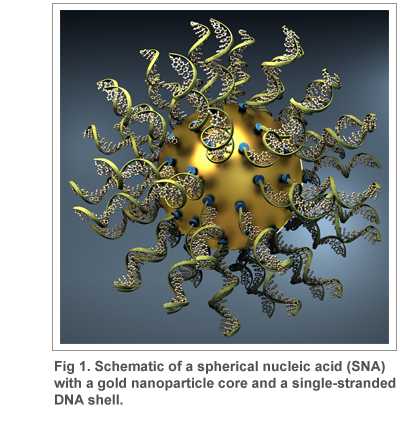
|
They have emerged as important tools in the life sciences and biomedicine, enabling advances in the development of high sensitivity, point-of-care medical diagnostic tools (SNAs can serve as labels for assays that take place both outside and inside of living cells) and therapeutics (SNAs can act as potent gene regulation and immunotherapy agents). Indeed, SNAs, structures with no known natural equivalent, are unlocking the potential of nucleic acids in these fields due to their unique architecture-dependent chemical and physical properties. Furthermore, SNAs can be used as “programmable atom equivalents” (PAEs) to build designer crystalline materials, where the lattice symmetry and spacing can be tailored through choice of nanoparticle size and composition and nucleic acid length and sequence. These nucleic acids function as programmable “bonds” between nanoparticle “atoms” and can be analogized to a nanoscale genetic code for directing particle assembly. The tunability of these nucleic acid bonds allows one to define a powerful set of design rules for synthesizing superlattices with more than 30 distinct lattice symmetries, in multiple well-defined crystal habits. These SNA-based superlattice materials can dynamically respond to biomolecular stimuli, including other nucleic acids and enzymes, such that their structure, properties, and functions can be tailored on demand. This unique genetic approach to materials design yields nanoparticle architectures that can be used to catalyze chemical reactions, manipulate light-matter interactions, investigate energy transfer between nanostructures, and improve our fundamental understanding of crystallization processes. |
 Nanoscience and technology hold promise to transform diverse fields spanning medicine, information technology, electronics, materials science, chemistry, energy, and the environment. Nanomaterials, in particular, are facilitating rapid and meaningful advances at the intersection of biology, chemistry, and medicine. This is due in part not only to their multi-functionality, but also their size, which is ideal for interacting with biological structures, both in vitro and in vivo. Spherical nucleic acids (SNAs), structures first reported by our group in 1996, are typically composed of spherical nanoparticles functionalized with a dense array of highly oriented oligonucleotides (e.g., DNA, RNA) (Figure 1).
Nanoscience and technology hold promise to transform diverse fields spanning medicine, information technology, electronics, materials science, chemistry, energy, and the environment. Nanomaterials, in particular, are facilitating rapid and meaningful advances at the intersection of biology, chemistry, and medicine. This is due in part not only to their multi-functionality, but also their size, which is ideal for interacting with biological structures, both in vitro and in vivo. Spherical nucleic acids (SNAs), structures first reported by our group in 1996, are typically composed of spherical nanoparticles functionalized with a dense array of highly oriented oligonucleotides (e.g., DNA, RNA) (Figure 1).